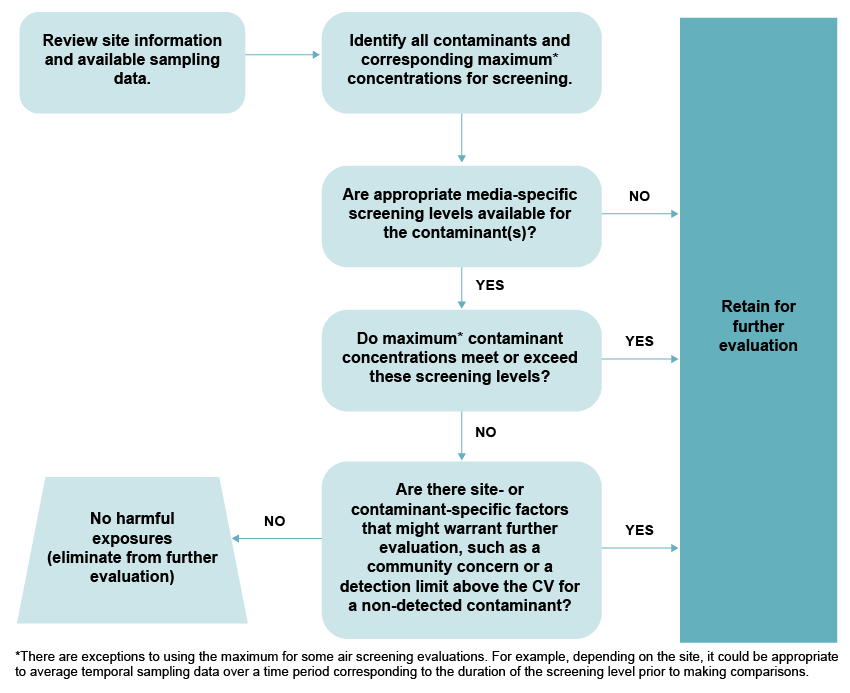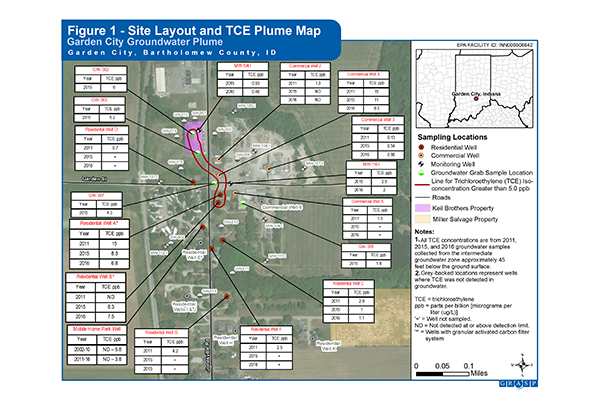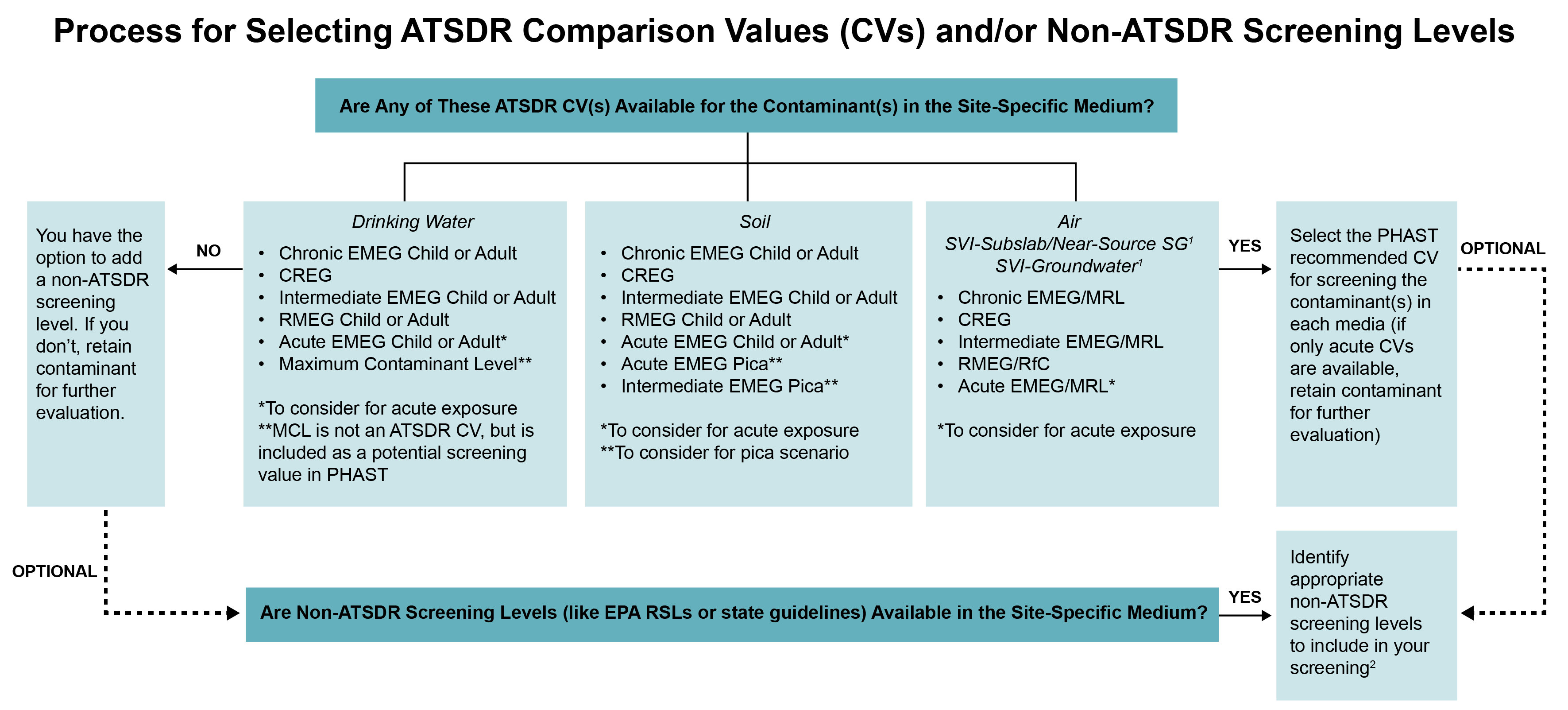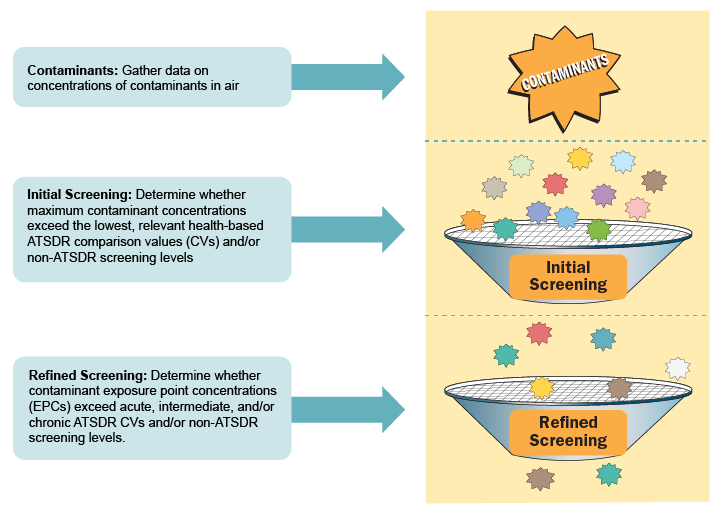Screening Analysis Steps
This section explains the five steps in the screening analysis and provides useful resources for completing the different steps.
You will follow ATSDR’s process and decision logic to examine contaminants during the screening analysis (see process diagram).
The screening analysis has five main steps:
- Review site information obtained from various sources (e.g., sampling event trip reports, site histories, stakeholder input), and review available sampling data.
- Identify all contaminants and corresponding maximum concentrations for screening (except for some air screening evaluations where the maximum is not the most appropriate value to use). If compiling a larger data set and using PHAST (as recommended), health assessors should use the PHAST data import spreadsheet.
- Select appropriate ATSDR CVs and/or non-ATSDR screening levels (see text box).
- Conduct the comparison and identify contaminants whose maximum or appropriate air concentration meets or exceeds the screening level, or that have no appropriate available screening level, and require further evaluation.
- Check if there are site- or contaminant-specific factors that might warrant further evaluation (e.g., a contaminant is a community concern, the laboratory-reported detection limit for a non-detected contaminant is higher than ATSDR’s recommended CV).
After completing these steps, you will have divided contaminants identified at the site into two categories:
- Contaminants requiring no further analysis (below established health-based screening levels).
- Contaminants requiring further evaluation because they either meet or exceed established screening levels, have no screening levels available, have only acute CVs available, or represent a contaminant that requires further evaluation (e.g., a contaminant that is a community concern).
You will examine the contaminants identified as requiring further evaluation in the next scientific evaluation component of the PHA process: EPCs and Exposure Calculations.
Health assessors need to use the most appropriate and up-to-date ATSDR CVs and non-ATSDR screening levels. ATSDR and other agencies regularly update their screening levels. Always seek the most current screening levels available at the time of your evaluation. Keep the data files you used to perform the screening analysis and prepare your screening tables, so you can do a final check of the screening levels before you put the last touches on your report.
The most current ATSDR CVs are stored in PHAST, which health assessors can request access to by emailing phast@cdc.gov. When you use PHAST’s CV Module for the screening analysis, the most current CVs will be incorporated automatically.
Non-ATSDR screening levels are not stored in PHAST. Common sources of non-ATSDR screening levels include EPA’s Regional Screening Levels (RSLs), National Ambient Air Quality Standards (NAAQS), and Lifetime Health Advisories (LTHAs), as well as other federal agencies and state health and environmental agencies. Check the websites of the federal and state screening level sources, or contact those entities directly, to obtain the most current values to use in your screening analysis. This table lists various types of non-ATSDR screening levels.
Note that ATSDR does not endorse the use of any non-ATSDR screening level, but this list includes sources suggested by health assessors for various types of non-ATSDR screening levels. Many available non-ATSDR screening levels are based on health effects observed in scientific studies, but others are not completely health-based. Before using them in your screening analysis, ensure you understand how the non-ATSDR screening levels were derived and discuss their possible use with the Associate Director for Science (ADS) group (see text box).

During the first step of the screening analysis, health assessors review all available site information, obtained for example during the site visit. If appropriate, examine your data by exposure unit.
You will also review all of the available sampling data to familiarize yourself with the data you have, such as the contaminants detected, media sampled, number of samples collected, and sample locations.
You might also look for useful maps to use in your analysis and insert in your document (e.g., PHA, HC). For example, if you are dealing with groundwater contamination, a plume map that shows site boundaries and adjacent affected properties would be a good visual.

Example of a useful type of map. Click here to view a larger image.
During Step 2 of the screening analysis, health assessors compile all their data in an electronic format, identifying each contaminant and corresponding maximum concentration in each medium. If you are compiling a larger data set and using PHAST (as recommended for health assessors), use the application’s data import spreadsheet template to insert the necessary information for each contaminant and its corresponding maximum concentration (e.g., media, unit). It is important to recognize that compiling these data can often be a significant effort, requiring professional judgment, before you are ready to put data into the PHAST import spreadsheet.

Health assessor entering information electronically.
ATSDR typically uses the maximum concentration for screening; however, there are exceptions for some air screening evaluations. For example, depending on the site, it could be appropriate to average temporal sampling data over a time period corresponding to the duration of the screening level prior to making comparisons. To illustrate this, imagine you have 1-hour air sampling data for a contaminant and you want to screen against an available 24-hour non-ATSDR air screening level. To do this, instead of using a maximum concentration, you average all of your daily 1-hour concentrations to determine if the maximum daily average is above the 24-hour non-ATSDR screening level.
Step 3: Select Appropriate Screening Levels
ATSDR has developed a process diagram to help health assessors identify appropriate ATSDR CVs and/or non-ATSDR screening levels. When several ATSDR CVs are available for a contaminant in a particular medium, health assessors usually use the lowest available CV (the most health protective) to identify potential contaminants of concern. When using PHAST, the application will flag the recommended CV to use for each contaminant.
Use the following questions and decision flow when selecting ATSDR CVs and non-ATSDR screening levels:
- Are ATSDR CVs available for the contaminant(s) in the site-specific medium?
- Yes: Select the PHAST-recommended CV for screening. If only acute CVs are available, retain the contaminant for further evaluation, regardless of whether the acute CVs are exceeded.
- No: You have the option to add a non-ATSDR screening level for your site in PHAST. If you do not add the screening level, retain the contaminant for further evaluation.
- Are non-ATSDR screening levels available?
Why is the soil-pica CV not the recommended CV when conducting your screening in PHAST?
The reason is because when you compare your maximum concentration of a contaminant to the recommended CV in PHAST, it is generally protective for soil-pica contaminant exposures. One exception to this rule is if copper is a contaminant of potential concern at your site. ATSDR has determined that the recommended CV for copper, which is the child intermediate EMEG, is not protective for soil-pica exposures. Therefore, health assessors should use the soil-pica CV for copper in their screening analysis.

Notes:
CREG = cancer risk evaluation guide PHAST = Public Health Assessment Site Tool
CV = comparison value RfC = reference concentration
EMEG = environmental media evaluation guide RMEG = reference dose media evaluation guide
EPA = U.S. Environmental Protection Agency RSL = regional screening level
MCL = maximum contaminant level SG = soil gas
MRL = minimal risk level SVI = soil vapor intrusion
1Soil intrusion CVs identify subsurface concentrations that indicate the need for indoor air sampling to evaluate air exposures. See ATSDR’s Vapor Intrusion Guidance [PDF – 1,769 KB] for details.
2 Non-ATSDR screening levels might be used if they are lower (i.e., more health protective) than ATSDR CVs, in addition to ATSDR-derived CVs, or when ATSDR CVs are not available. In cases where a non-ATSDR screening level is adequately protective of public health and lower than ATSDR’s recommended CV for the same exposure duration, health assessors can use that lower level after receiving approval by the Associate Director for Science (ADS). In their document, health assessors need to discuss all of the screening levels used in their evaluation.
Remember the following key points when selecting screening levels:
- Use an ATSDR CV for screening if one is available. If no ATSDR CV is available, you are not required to look for another screening level. You can simply retain the contaminant for further evaluation. However, there are some exceptions. For example, some essential nutrients (e.g., calcium, iron, magnesium) are typically not harmful under most environmental exposure scenarios. It can be helpful to compare these and other naturally occurring elements to nutritional levels as well as media-specific background concentrations when assessing the need for further examination. Another example to this exception is if you have a health-based non-ATSDR screening level that is more protective than the ATSDR CV (see the next bullet).
- You have the option to use a non-ATSDR screening level. Non-ATSDR screening levels might be used if they are lower (i.e., more health protective) than ATSDR CVs, in addition to ATSDR-derived CVs, or when ATSDR CVs are not available. Before using these, you must ensure they are appropriate (see text box). Note that in cases where the non-ATSDR screening level is adequately protective of public health and lower (i.e., more health protective) than ATSDR’s recommended CV for the same exposure duration, then health assessors can use that level instead of ATSDR’s CV. In this case, the preferred method is for health assessors to document the use of only the lower non-ATSDR screening level in their report, but they can include both the non-ATSDR screening level and ATSDR CV in their report if they want to.
- Recognize that many types of screening levels are available from various sources. These can be derived from different methodologies. Before choosing a non-ATSDR screening level, be sure to understand its derivation and use to ensure its application in the screening analysis is adequately protective of public health. For example, some states go through a rigorous peer review process while others might not. Historically, ATSDR has accepted EPA screening levels above other sources.
- Ensure the screening level is appropriate for human health evaluation. You will need to determine the basis for the level, confirm that it is appropriate for use in the screening analysis, and if selected for use, discuss the selection process of the non-ATSDR screening level with a subject matter expert (SME), toxicologist, or ADS group to confirm its appropriateness (see text box). For example, some screening levels are derived for environmental screening or other environmental purposes rather than for evaluating human health concerns. If the non-ATSDR screening level you identified is deemed appropriate for inclusion, discuss the use of this screening value in your document.
In Step 4, health assessors compare the maximum concentration for each contaminant (or alternate concentration for some air evaluations) identified in Step 2 with the recommended contaminant-specific ATSDR CV and/or non-ATSDR screening level identified in Step 3. During this step, you will screen to see if the appropriate concentration selected for each contaminant meets or exceeds the selected CV and/or non-ATSDR screening level, and if so, retain those contaminants for further evaluation.
Here are some important points to consider when performing the comparison:
- Ensure your data are in the same units as the ATSDR CVs and non-ATSDR screening levels you are using. (Note: If you’re using PHAST, the system will convert your concentration to ATSDR’s default media-specific unit [in air, users can choose between two units]).
- Make sure each screening level is for the same contaminant you are comparing it to. Many contaminant names look similar, so it’s always best to double-check. Using the contaminant’s Chemical Abstracts Service Registration Number (CASRN) can help. If you’re using PHAST, the system will provide the CASRN and synonyms.
- For some air screening evaluations, there are exceptions to using the maximum. For example, depending on the site, it could be appropriate to average temporal sampling data over a time period corresponding to the duration of the screening level prior to making comparisons. Please contact an SME for more information, if needed.
Based on the information discussed so far, you know to retain contaminants for further evaluation when:
- Maximum concentrations (or for some air evaluations, statistically representative exposure concentrations) meet or exceed ATSDR CVs and/or non-ATSDR screening levels.
- No ATSDR CVs and/or non-ATSDR screening levels are available for screening.
- ATSDR only has acute CVs available.
Additional considerations for when to retain contaminants are covered in Step 5 of the screening analysis.
Generally, the screening analysis is a simple comparison of contaminant concentrations against media-specific screening levels. However, during Step 5 of the screening analysis, you will determine if any site- or contaminant-specific factors need to be considered before including or excluding a contaminant from further evaluation.
Tip: As the screening analysis progresses, be careful not to inadvertently dismiss a contaminant that should be identified for further evaluation or doing the opposite—conduct an extensive evaluation of a contaminant that is unlikely to cause adverse health effects at detected levels and conditions of likely exposure.
Consider the following factors:
- Community concerns. As mentioned throughout this e-manual, community concerns are important to the PHA process. Therefore, when a community has expressed special concern about a particular contaminant or exposure, whether CVs are exceeded or not, you should include this contaminant for evaluation and discussion.
- Detection limits. When looking through your data set, you will need to examine whether the laboratory-reported detection limits for non-detected contaminants were higher than ATSDR’s recommended CVs. When a detection limit for a contaminant was below the CV, then a health assessor can eliminate it from further evaluation. As a thorough check, you can input the reported detection limits in PHAST as the concentration for each contaminant in each medium with non-detect results and have PHAST run a compare in its CV Module. The PHAST results table will then flag each contaminant with a detection limit that exceeds the recommended contaminant-specific ATSDR CV. Based on these results, you will know if any non-detected contaminant might require further evaluation because its detection limit was above ATSDR’s recommended CV.
- Multiple pathways of exposure. People can be exposed to contaminants in more than one environmental medium (e.g., in both water and soil). While contaminant concentrations in one medium might not exceed screening levels, contaminants detected in more than one medium could compound potential exposures. For example, you might further evaluate the possible combined effects of a contaminant found in drinking water, surface soil, and air, even though media-specific screening levels are not exceeded. You might also retain a contaminant found below its screening level in one medium (e.g., soil) if this contaminant was also found above its screening level in another medium (e.g., water). Be cautious, however, when assessing contaminants across pathways. Effects are not always additive, and the most sensitive health endpoints may differ. Exposure parameters, such as the frequency of exposure, for a single contaminant can vary by medium and route of exposure.
- Multiple-contaminant exposures. Community members are often concerned about exposure to multiple contaminants. Generally, if detected levels of contaminants are individually below conservative screening values, then exposure to these contaminants collectively is not expected to be of health concern. Even so, you may decide that further evaluation of multiple-contaminant exposures is necessary. In these instances, you would estimate EPCs and perform exposure calculations, and if deemed necessary, perform further in-depth analysis, in consultation with a toxicologist.
During this Step 5 of the screening analysis, ask questions such as the following to determine if certain factors need further examination:
- Is the contaminant of community concern, even if the maximum concentration was below ATSDR CVs and non-ATSDR screening levels?
- Was the contaminant not detected, but the detection limit is above the recommended ATSDR CV?
- Are there possible combined effects from exposures, including background, to a contaminant through multiple pathways that may need further investigation?
- Is there a concern about possible exposures to multiple contaminants?
Following the screening analysis, health assessors will examine the contaminants identified as requiring further evaluation in the next scientific evaluation component of the PHA process: EPCs and Exposure Calculations

Refer to Module 6, Data Screening Analysis, in ATSDR’s Public Health Assessment Training (PHAT) course. Learn more about the screening analysis, see case study examples, and perform case study exercises. The link below will take you to the module’s registration page in CDC TRAIN.
ATSDR requires health assessors to perform a minimum of one conservative screen as discussed in this section and demonstrated in the previous steps, which involves comparing the maximum concentration (or other appropriate concentration for some air screenings) to the ATSDR recommended CV or non-ATSDR screening level. This guidance manual focuses on the process to perform the required single conservative screen.
For air evaluations, however, health assessors may deem it appropriate to perform a two-tier screening analysis, using an initial screen followed by a refined screening. The Initial and Refined Screening Illustration outlines this approach, and the Public Health Assessment for Corpus Christi Refineries [PDF – 20.8 MB] is an example of a site where ATSDR used this approach. Before using this two-tier approach, consult with the ADS Group to ensure it is appropriate for your site.
Initial and Refined Screening Illustration
